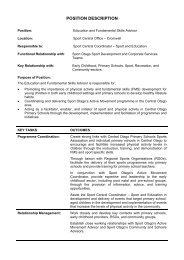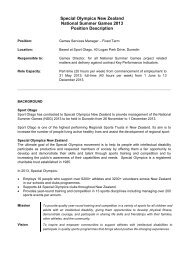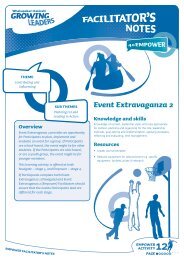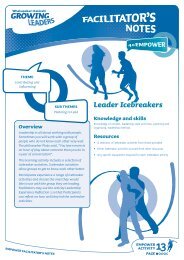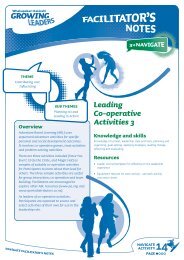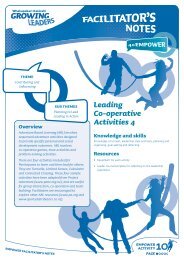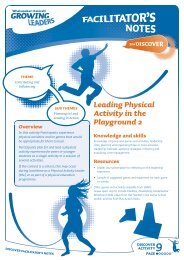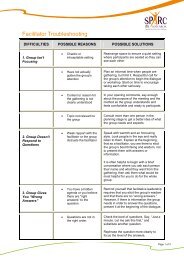Read Getting Set for an Active Nation - Sport New Zealand
Read Getting Set for an Active Nation - Sport New Zealand
Read Getting Set for an Active Nation - Sport New Zealand
Create successful ePaper yourself
Turn your PDF publications into a flip-book with our unique Google optimized e-Paper software.
Cost of Lives Lost<br />
The causal relationship between physical inertia <strong>an</strong>d heightened health risks suggests<br />
that, in Australia <strong>for</strong> example, 122 deaths per year from coronary heart disease, noninsulin<br />
dependent diabetes <strong>an</strong>d colon c<strong>an</strong>cer may be prevented <strong>for</strong> each 1% increase<br />
of the population who achieve a level of sufficient physical activity (Stephenson et al.,<br />
1996 p.vii-viii). Unnecessary deaths have impacts upon medical costs <strong>an</strong>d lost<br />
contributions to the national economy.<br />
The most persuasive proof concerns the prevention of coronary heart disease, which<br />
continues to kill more <strong>New</strong> Zeal<strong>an</strong>ders, often at a relatively young age, th<strong>an</strong> <strong>an</strong>y other<br />
disease. Individuals who are regularly active have half the risk from this disease th<strong>an</strong><br />
those with a sedentary lifestyle (Berlin <strong>an</strong>d Colditz, 1990; Powell et al., 1987), <strong>an</strong>d in<br />
the United States one-third of the <strong>an</strong>nual deaths from coronary disease c<strong>an</strong> be<br />
attributed to insufficient physical activity (Powell <strong>an</strong>d Blair, 1994).<br />
4.4 The Cost of Doing Nothing<br />
The Task<strong>for</strong>ce asks the question, “How much does it matter to <strong>New</strong> Zeal<strong>an</strong>ders to save<br />
lives <strong>an</strong>d reduce expenditure by supporting physical activity, recreation <strong>an</strong>d sport?”<br />
The evidence of physical activity as the key to making <strong>New</strong> Zeal<strong>an</strong>d a healthier nation<br />
underpins social <strong>an</strong>d economic benefits. Governments have been told this but have<br />
consistently abstained from addressing this as the key to a fitter <strong>an</strong>d more productive<br />
society. Government must support physical activity as active lives prevent illness <strong>an</strong>d<br />
generate a more productive elderly sector.<br />
Physical activity results in economic benefits <strong>an</strong>d signific<strong>an</strong>t savings <strong>for</strong> <strong>New</strong> Zeal<strong>an</strong>d in<br />
direct medical costs (e.g. ambul<strong>an</strong>ce, in-patient <strong>an</strong>d out-patient treatment,<br />
rehabilitation, medical services, pharmaceuticals consumption), <strong>an</strong>d indirect costs<br />
(such as the loss of productivity or absences from the workplace, <strong>an</strong>d costs ensuing<br />
from the reduction of quality of life due to pain, disability, bereavement or suffering).<br />
• An example of the result of governmental inaction is seen in relation to some<br />
7,800 <strong>New</strong> Zeal<strong>an</strong>ders who die each year from coronary disease, colon c<strong>an</strong>cer <strong>an</strong>d<br />
diabetes, with one-sixth to one-fifth attributed to physical inactivity. Doing nothing<br />
will me<strong>an</strong> the wasted deaths of 1,300 of the <strong>New</strong> Zeal<strong>an</strong>ders each year.<br />
• In 1996, the avoidable mortality rate <strong>for</strong> Maori (0-74 years) was 2.5 times, <strong>an</strong>d <strong>for</strong><br />
Pacific people 2.0 times, higher th<strong>an</strong> the Europe<strong>an</strong>/Other rate.<br />
• Maori <strong>an</strong>d Pacific people (0-74 years) have rates of avoidable hospitalisation about<br />
60 percent higher th<strong>an</strong> Europe<strong>an</strong>/Others.<br />
• In 1997-98, almost one-third of all the hospitalisations in the 0-74 years age group<br />
were potentially avoidable, through health promotion or primary health care.<br />
• Physical inactivity accounts <strong>for</strong> about eight percent of <strong>an</strong>nual deaths with obesity<br />
<strong>an</strong>d diabetes each responsible <strong>for</strong> about four to five percent of these deaths.<br />
Ministerial Task<strong>for</strong>ce on <strong>Sport</strong>, Fitness & Leisure J<strong>an</strong>uary 2001 page 48 of 153




